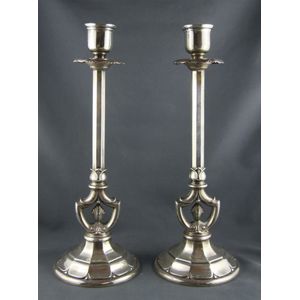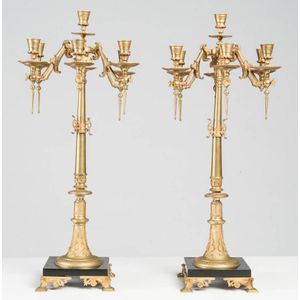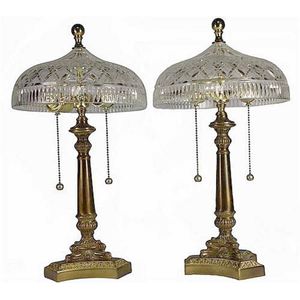Bronze Twin Light Argand Lamp with Frosted Shades
A William IV bronze twin light argand lamp, the facetted urn shaped reservoir above a pair of foliate scrolled arms with frosted shades, on a pedestal base with recessed panels and quatrefoils, electrified, height 47 cm, width 47 cm
You must be a subscriber, and be logged in to view price and dealer details.
Subscribe Now to view actual auction price for this item
When you subscribe, you have the option of setting the currency in which to display prices to $Au, $US, $NZ or Stg.
This item has been sold, and the description, image and price are for reference purposes only.
- Foliate - Decorated with leaves or leaf-like forms.
- Faceting - Faceting is a technique of removing material from a curved surface, to give a series of flat surfaces but retaining the profile of the original surface.
The technique is most commonly associated with diamond cutting where the various cuts used such as rose cut and brilliant cut, add life and sparkle to the stone, whilst at the same time removing as little of the stone as possible.
Faceting by grinding is also used to decorate glass. The stems of many drinking glasses are decorated by cutting a series of flat surfaces on a circular stem, and hollow vessels such as vases may have faceted surfaces.
In furniture faceting is often applied to legs of tables and chairs, where a circular baluster shaped section is flattened so as to form an octagonal section. - William Iv - William IV was King of the United Kingdom and King of Hanover from 26 June 1830 until his death in 1837, and in English furniture design it represented the brief period between the end of the Regency period, and the beginning of the Victorian period.
- Bronze - An alloy of copper and tin, traditionally in the proportions of about 9 parts of copper to 1 part of tin.
The discovery of bronze in Western Asia in the 4th century enabled people to create metal objects which were superior to those previoulsy possible because of its strength and hardness, and it has been used throughout the world for weapons, coins, tools, statuary and other decorative items.
It is very fluid in a molten state, and its hardness, strength when set, and non-corrosive properties makes it most suitable for casting sculpture.
This item has been included into following indexes:
Visually similar items

A pair of American sterling silver candlesticks. Marked Gorham sterling. 28 cm high.
Sold by
in
for
You can display prices in $Au, $US, $NZ or Stg.

A pair of Victorian gilt brass six-light candelabra, circa 1880. 72 cm high
Sold by
in
for
You can display prices in $Au, $US, $NZ or Stg.

Banquet Lamp: Brass Corinthian column base with cut crystal font, Young's double button burner (bayonet mount) & original etched glass shade. Height 78 cm
Sold by
in
for
You can display prices in $Au, $US, $NZ or Stg.

Waterford Crystal pair of bedside lamps on gilded metal bases. Height 46 cm
Sold by
in
for
You can display prices in $Au, $US, $NZ or Stg.
